Temperature Effects, Frieden–Hawkins’ Order-Measure, and Wehrl Entropy
Abstract
:1. Introduction
- We begin our considerations in Section 2 by sketching basic notions regarding Frieden–Hawkins’ order measure.
- In Section 3 we do a similar introductory exposition to basic semiclassical ideas, which is necessary because we will compare/assess the Frieden–Hawkins order-concept with semiclassical quantifiers. After these somewhat lengthy preparations, we develop our present ideas and results.
- In Section 4 we investigate order with reference to the process of coarse-graining, as applied to the Wigner function.
- In Section 5 we revisit again the FH order notion, this time with regard to the Kerr effect.
- Finally, some conclusions are drawn in Section 6.
2. Frieden–Hawkins Order Measure: A Brief Review
2.1. Coarse Graining
2.2. Fisher Order Measure
2.3. Some Features of the Frieden–Hawkins Order Measure
- is dimensionless (neither length, nor time, nor mass), which has the benefit of allowing completely different phenomena to be compared for their levels of order;
- is invariant under uniform stretching xk → akxk, k = 1, …, K, with the ak = constants; and
- measures the number of ordered “details” within the system, rather than their density of structure—e.g., for a one dimensional system p(x) = (2/a) sin2(nπx/a), 0 ≤ x ≤ a the order = 4π2n2 This is independent of the system extension a and, instead, is purely a rapidly increasing function of the total number n of sinusoidal waves within the system.
- dimensionless (no length, time, mass);
- translationally invariant;
- dependent on the number of details.
2.4. Previous FH-applications
3. The Semiclassical Approach
3.1. Semiclassical Quantifiers
3.1.1. Wigner’s Distribution
3.1.2. Husimi’s Distribution
3.1.3. Wehrl Entropy
3.1.4. Semiclassical Fisher Information
4. Order and Coarse-Graining


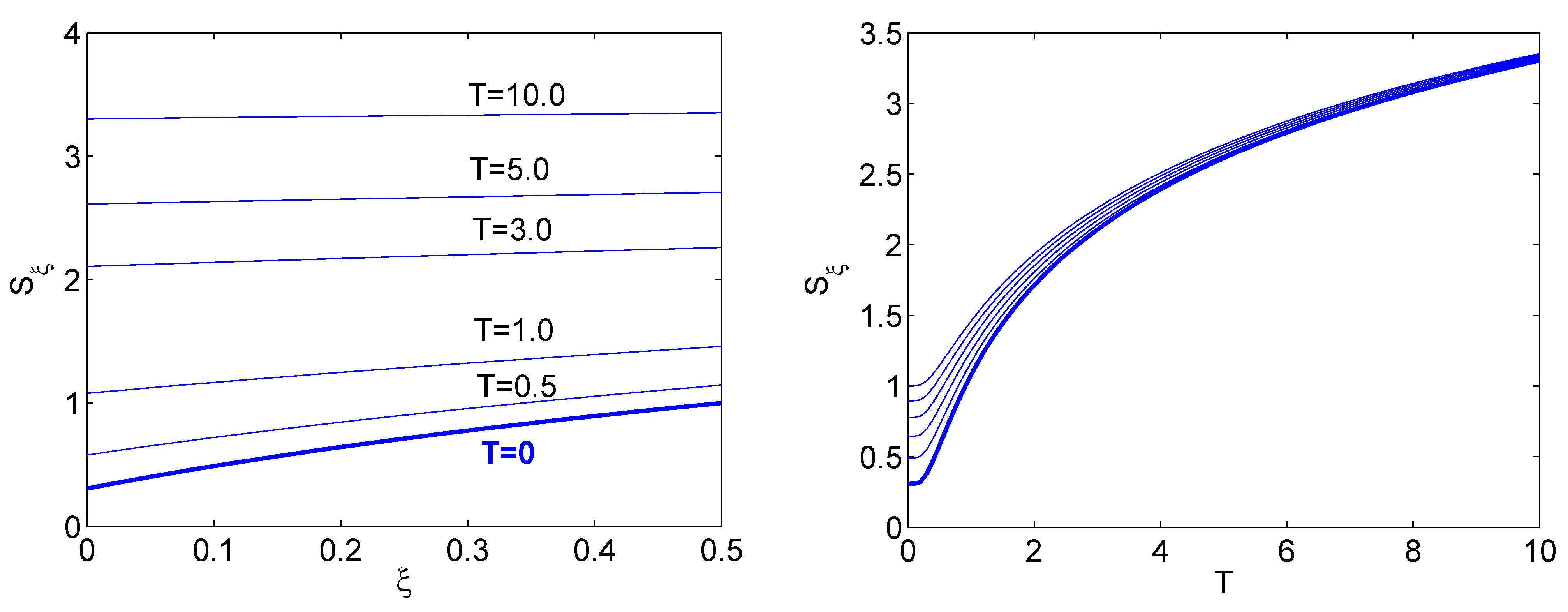
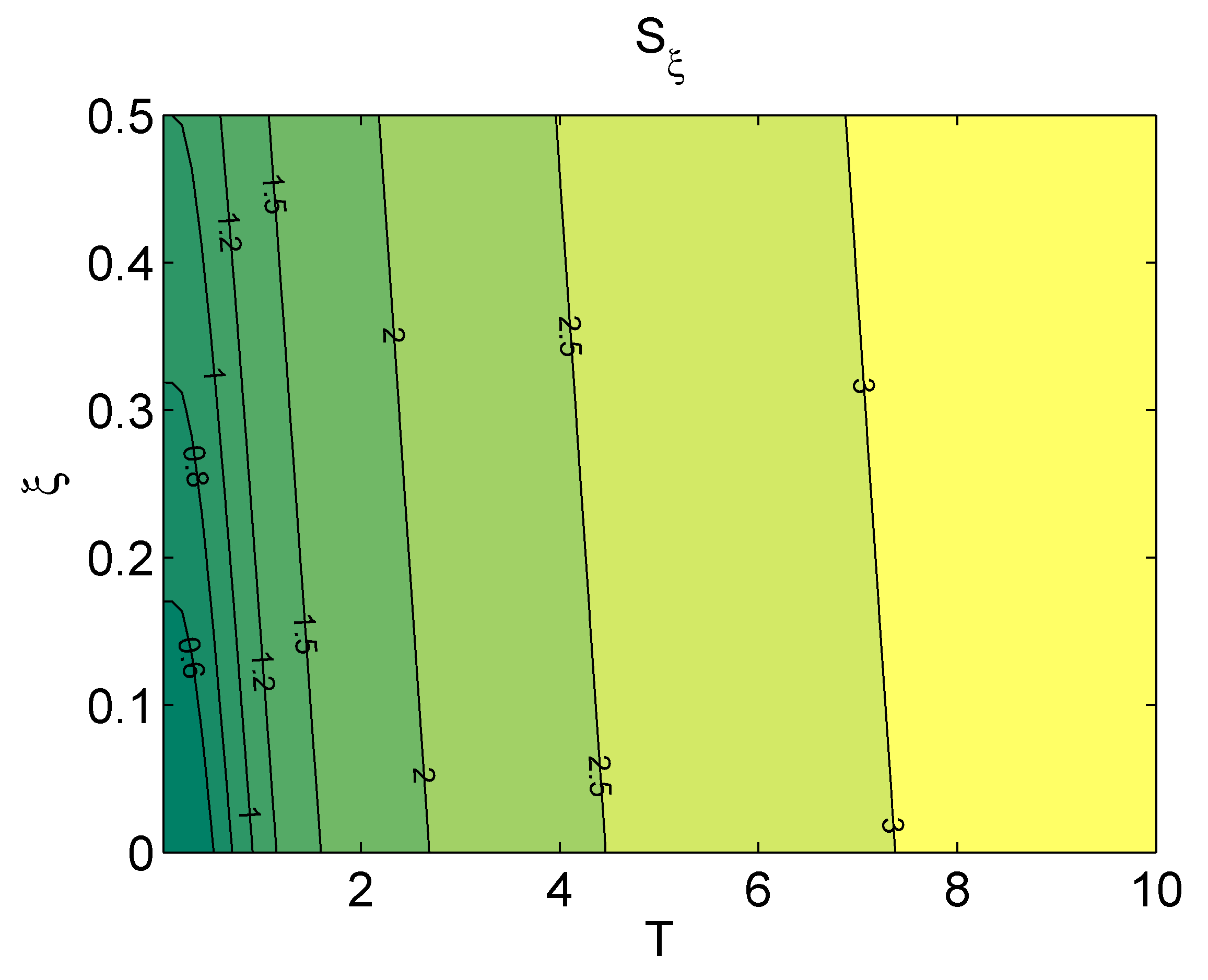
5. Kerr Effect
5.1. Husimi Distribution, Wehrl Entropy and FH-order for a Kerr Medium

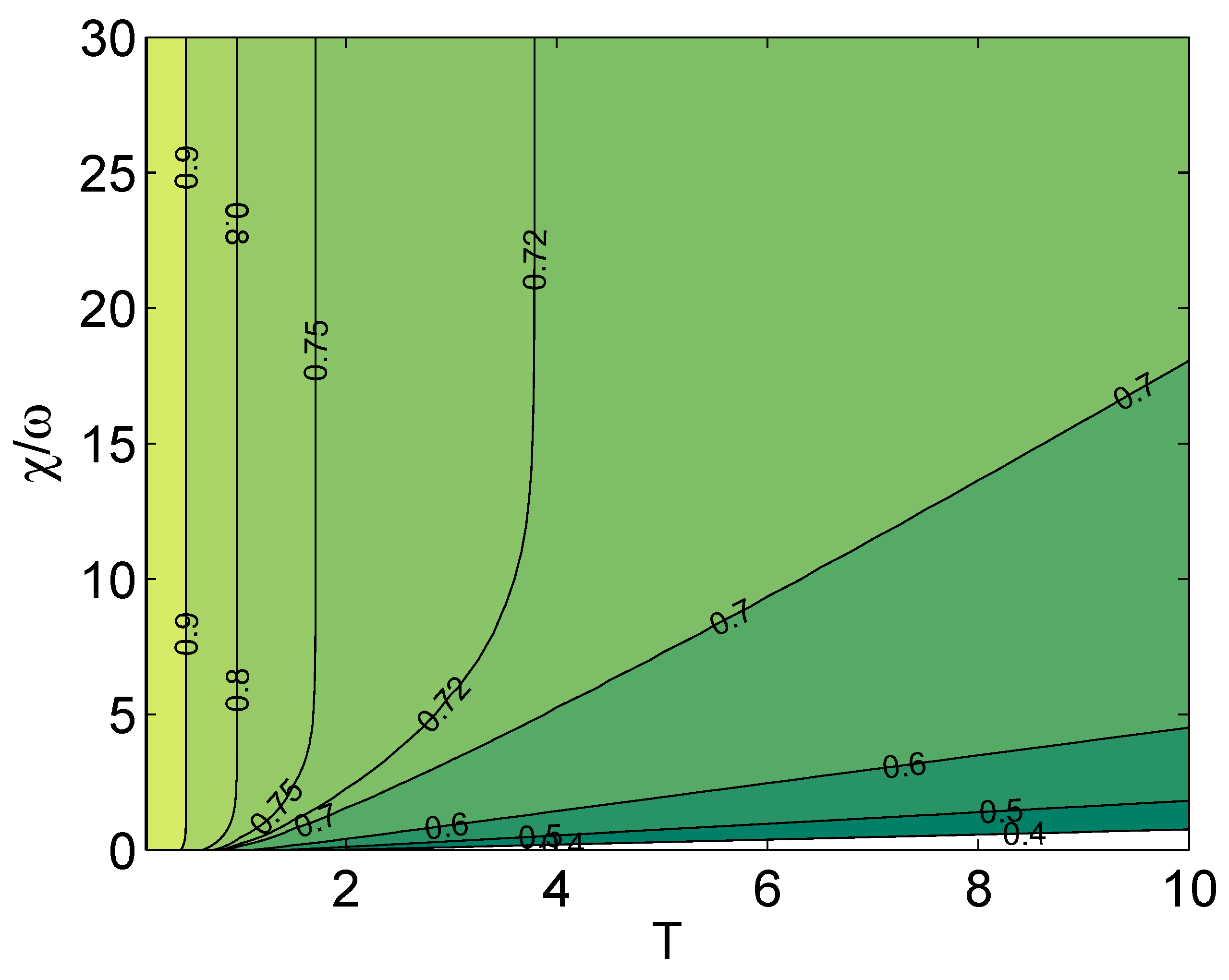
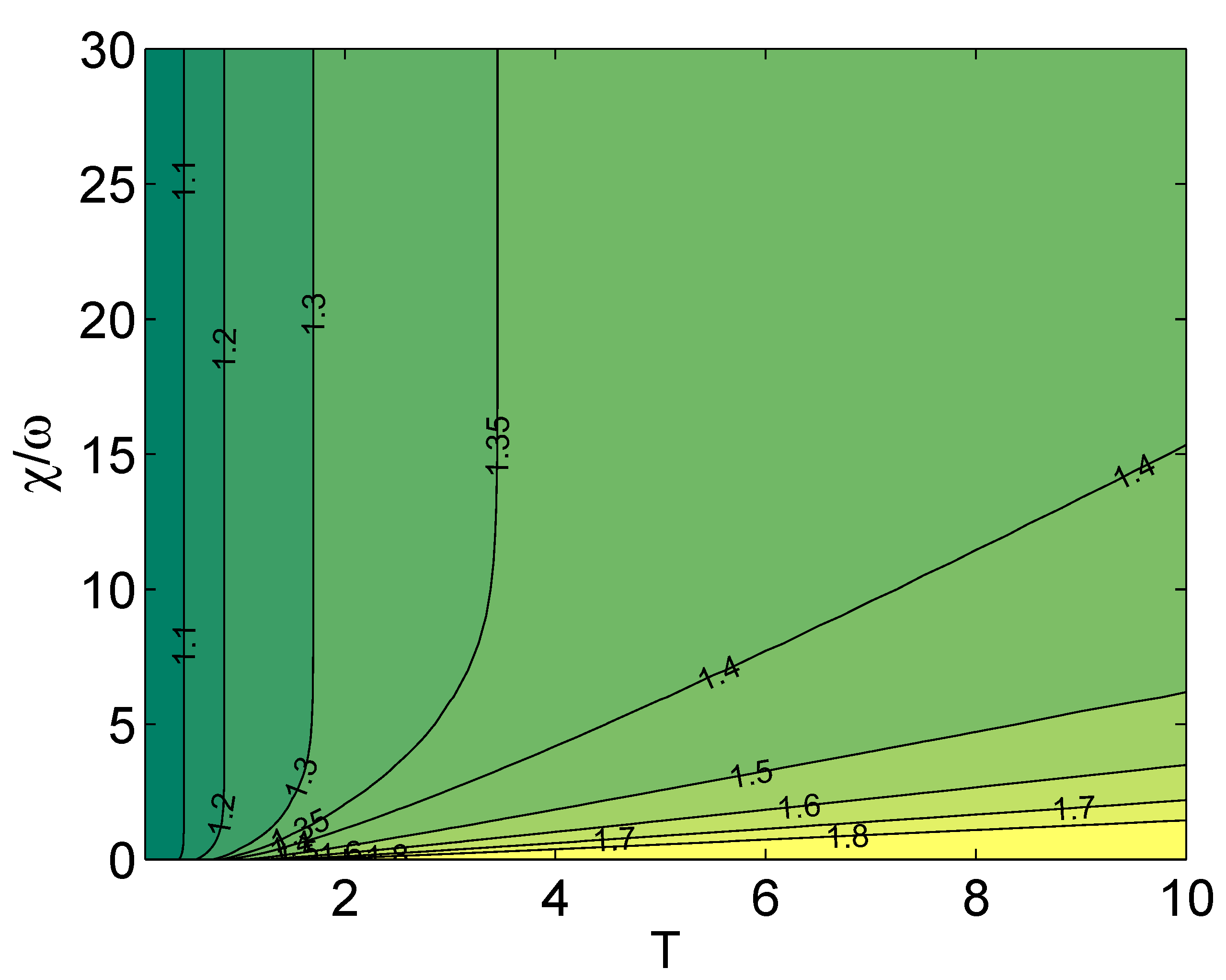
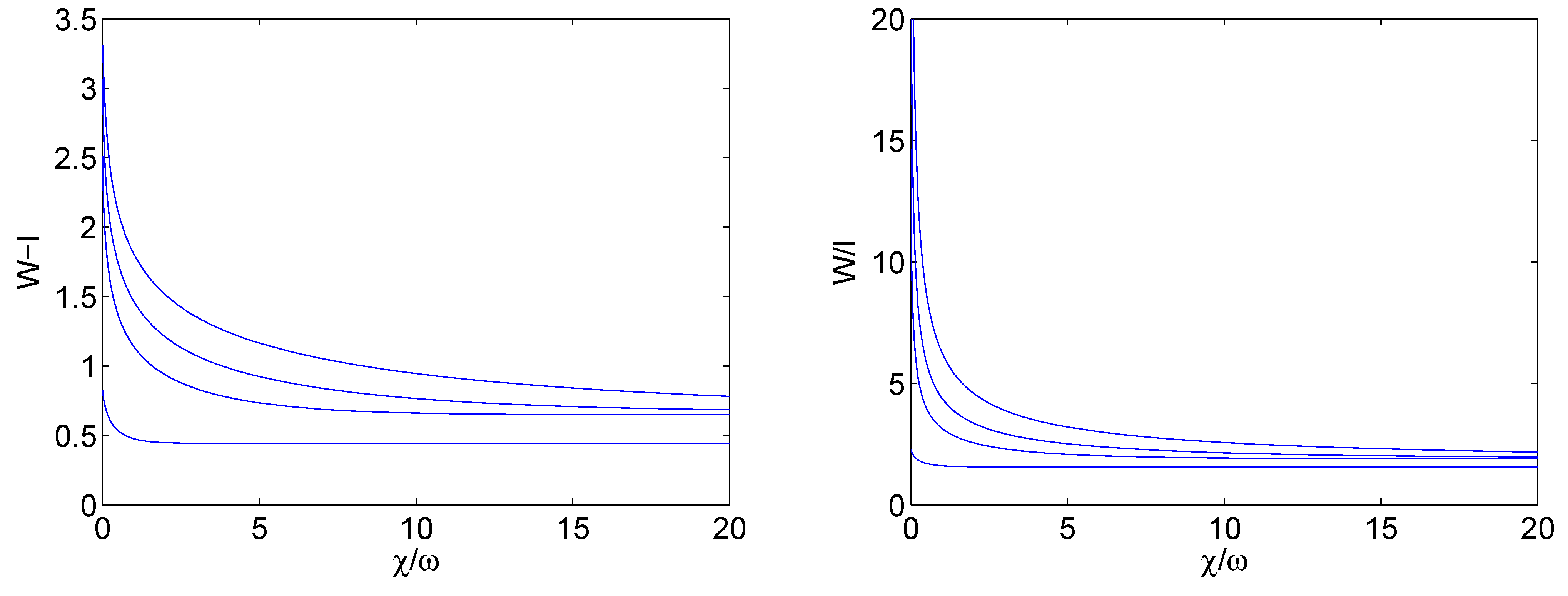
6. Conclusions
- the Frieden–Hawkins order-measure behaves in appropriate manner vis-a-vis (i) temperature and (ii) an aligning interaction Hamiltonian.
- The Wehrl or Shannon entropies are as good indicators of disorder as the Fisher’s order measure is of order, given their compliance with the features summarized in Section (2.3). It is intuitively clear that entropy measures disorder. What we are saying here is that, quantitatively, it does it in a way entirely similar to that for order in the FH-case.
Acknowledgements
References
- Frieden, B.R.; Hawkins, R.J. Quantifying system order for full and partial coarse graining. Phys. Rev. E 2010, 82. [Google Scholar] [CrossRef]
- Dimassi, M.; Sjoestrand, J. Spectral Asymptotics in the Semi-Classical Limit; Cambridge University Press: Cambridge, UK, 1999. [Google Scholar]
- Brack, M.; Bhaduri, R.K. Semiclassical Physics; Addison-Wesley: Reading, MA, USA, 1997. [Google Scholar]
- Arnheim, R. Entropy and Art: An Essay in Disorder and Order; University of California Press: Berkeley, CA, USA, 1971. [Google Scholar]
- Darrigol, O. From c-Numbers to q-Numbers; University of California Press: Berkeley, CA, USA, 1992. [Google Scholar]
- Rosenkrantz, R.D. E.T. Jaynes: Papers on Probability, Statistics and Statistical Physics; D. Reidel: Dordrecht, The Netherlands, 1983. [Google Scholar]
- M. Gell-Mann, M.; Tsallis, C. Nonextensive Entropy: Interdisciplinary Applications; Oxford University Press: Oxford, UK, 2004. [Google Scholar]
- Tsallis, C. Introduction to Nonextensive Statistical Mechanics: Approaching a Complex World; Springer: New York, NY, USA, 2009. [Google Scholar]
- Schrödinger, E. What Is Life? The Physical Aspect of the Living Cell and Mind and Matter; Cambridge University Press: New York, NY, USA, 1967. [Google Scholar]
- Frieden, B.R.; Plastino, A.; Plastino, A.R. Fisher order measure and Petri’s universe. Phys. A 2012, 391, 2300–2305. [Google Scholar] [CrossRef]
- Frieden, B.R.; Gatenby, R.A. Order in a multidimensional system. Phys. Rev. E 2011, 84. [Google Scholar] [CrossRef]
- Frieden, B.R.; Plastino, A.; Plastino, A.R. Effect upon universal order of Hubble expansion. Phys. A 2011, 391, 410–413. [Google Scholar] [CrossRef]
- Frieden, B.R. Science from Fisher Information, 2 ed.; Cambridge University Press: Cambridge, UK, 2004. [Google Scholar]
- Kolmogorov, A.N. Three approaches to the quantitative definition of information. Problems Inform. Transmission 1965, 1, 1–7. [Google Scholar] [CrossRef]
- Chaitin, G.J. On the simplicity and speed of programs for computing infinite sets of natural numbers. J. ACM 1969, 16, 407–422. [Google Scholar] [CrossRef]
- Bradley, C.C.; Sackett, C.A.; Hulet, R.G. Bose-Einstein condensation of lithium: Observation of limited condensate number. Phys. Rev. Lett. 1997, 78, 985–989. [Google Scholar] [CrossRef]
- Anderson, M.H.; Ensher, J.R.; Matthews, M.R.; Wieman, C.E.; Cornell, E.A. Observation of Bose-Einstein condensation in a dilute atomic vapor. Science, 1995, 269, 198–201. [Google Scholar] [CrossRef] [PubMed]
- Davis, K.B.; Davis, K.B.; Mewes, M.O.; Andrews, M.R.; van Druten, N.J.; Durfee, D.S.; Kurn, D.M.; Ketterle, W. Bose-Einstein condensation in a gas of sodium atoms. Phys. Rev. Lett. 1995, 75, 3969–3973. [Google Scholar] [CrossRef] [PubMed]
- Wigner, E.P. On the quantum correction for thermodynamic equilibrium. Phys. Rev. 1932, 40, 749–759. [Google Scholar] [CrossRef]
- Weyl, H. Quantenmechanik und gruppentheorie. Z. Phys. 1927, 46, 1–46. [Google Scholar] [CrossRef]
- Moyal, J.E. Stochastic processes and statistical physics. J. Roy. Stat. Soc. B 1949, 11, 150–210. [Google Scholar]
- Zachos, C.; Fairlie, D.; Curtright, T. Quantum Mechanics in Phase Space; World Scientific: Singapore, 2005. [Google Scholar]
- Lee, H.W. Theory and application of the quantum phase-space distribution functions. Phys. Rep. 1995, 259, 147–211. [Google Scholar] [CrossRef]
- Wlodarz, J.J. Entropy and Wigner distribution functions revisited. Int. J. Theor. Phys. 2003, 42, 1075–1084. [Google Scholar] [CrossRef]
- Krivine, H.; Casas, M.; Martorell, J. Semiclassical expansions for confined n fermion systems. Ann. Phys. (NY) 1990, 200, 304–344. [Google Scholar] [CrossRef]
- Ozorio de Almeida, A.M. The Weyl representation in classical and quantum mechanics. Phys. Rep. 1998, 295, 265–342. [Google Scholar] [CrossRef]
- Husimi, K. Some formal properties of the density matrix. Proc. Phys. Math. Soc. Jpn. 1940, 22, 264–283. [Google Scholar]
- Mizrahi, S.S. Quantum mechanics in the Gaussian wave-packet phase space representation. Phys. A 1984, 127, 241–264. [Google Scholar] [CrossRef]
- Pennini, F.; Ferri, G.L.; Plastino, A. Fisher information and semiclassical treatments. Entropy 2009, 11, 972–992. [Google Scholar] [CrossRef]
- O’ Connell, R.F.; Wigner, E.P. Some properties of a non-negative quantum-mechanical distribution function. Phys. Lett. A 1981, 85, 121–126. [Google Scholar] [CrossRef]
- Mizrahi, S.S. Quantum mechanics in the Gaussian wave-packet phase space representation II: Dynamics. Phys. A 1986, 135, 237–250. [Google Scholar] [CrossRef]
- Mizrahi, S.S. Quantum mechanics in the gaussian wave-packet phase space representation III: From phase space probability functions to wave-functions. Phys. A 1988, 150, 541–554. [Google Scholar] [CrossRef]
- Anderson, A.; Halliwell, J.J. Information-theoretic measure of uncertainty due to quantum and thermal fluctuations. Phys. Rev. D 1993, 48, 2753–2765. [Google Scholar] [CrossRef]
- Zurek, W.H. Sub-Planck structure in phase space and its relevance for quantum decoherence. Nature 2001, 412, 712–717. [Google Scholar] [CrossRef] [PubMed]
- Karkuszewski, Z.P.; Jarzynski, C.; Zurek, W.H. Quantum chaotic environments, the butterfly effect, and decoherence. Phys. Rev. Lett. 2002, 89. [Google Scholar] [CrossRef]
- Wisniacki, D.A. Short-time decay of the Loschmidt echo. Phys. Rev. E 2003, 67. [Google Scholar] [CrossRef]
- Rivas, A.M.F.; Vergini, E.G.; Wisniacki, D.A. Smoothed Wigner functions: A tool to resolve semiclassical structures. Eur. Phys. J. D 2005, 32, 355–359. [Google Scholar] [CrossRef]
- Manfredi, G.; Feix, M.R. Entropy and Wigner functions. Phys. Rev. E 2000, 62, 4665–4674. [Google Scholar] [CrossRef]
- Rivas, A.M.F.; Ozorio de Almeida, A.M. Hyperbolic scar patterns in phase space. Nonlinearity 2002, 15, 681–693. [Google Scholar] [CrossRef]
- Wehrl, A. On the relation between classical and quantum entropy. Rep. Math. Phys. 1979, 16, 353–358. [Google Scholar] [CrossRef]
- Glauber, R.J. Coherent and incoherent states of the radiation field. Phys. Rev. 1963, 131, 2766–2788. [Google Scholar] [CrossRef]
- Klauder, J.R.; Skagerstam, B.S. Coherent States; World Scientific: Singapore, 1985. [Google Scholar]
- Pennini, F.; Plastino, A. Thermal effects in quantum phase-space distributions. Phys. Lett. A 2010, 374, 1927–1932. [Google Scholar] [CrossRef]
- Olivares, F.; Pennini, F.; Plastino, A. Phase space distributions from variation of information measures. Phys. A 2010, 389, 2218–2226. [Google Scholar] [CrossRef]
- Pennini, F.; Plastino, A.; Ferri, G.L. Statistical, noise-related non-classicality’s indicator. Central Eur. J. Phys. 2009, 7, 624–629. [Google Scholar] [CrossRef]
- Pennini, F.; Plastino, A.; Ferri, G.L.; Olivares, F.; Casas, M. Information, Deformed, κ-Wehrl entropies and semiclassical delocalization. Entropy 2009, 11, 32–41. [Google Scholar] [CrossRef]
- Pennini, F.; Plastino, A. Smoothed Wigner distributions, decoherence, and the temperature dependence of the classical-quantical frontier. Eur. Phys. J. D. 2011, 61, 241–247. [Google Scholar] [CrossRef]
- Haus, H. Waves and Fields Optoelectronics; Prentice Hall: New York, NY, USA, 1984. [Google Scholar]
- Wilson-Gordon, A.D.; V. Buz̆ec, V.; Knight, P.L. Statistical and phase properties of displaced Kerr states. Phys. Rev. A 1991, 44, 7647–7656. [Google Scholar] [CrossRef] [PubMed]
- Olivares, F.; Pennini, F.; Ferri, G.L.; Plastino, A. Note on semiclassical uncertainty relations. Braz. J. Phys. 2009, 39, 503–506. [Google Scholar] [CrossRef]
© 2012 by the authors; licensee MDPI, Basel, Switzerland. This article is an open access article distributed under the terms and conditions of the Creative Commons Attribution license ( http://creativecommons.org/licenses/by/3.0/).
Share and Cite
Pennini, F.; Plastino, A.; Ferri, G.L. Temperature Effects, Frieden–Hawkins’ Order-Measure, and Wehrl Entropy. Entropy 2012, 14, 2081-2099. https://doi.org/10.3390/e14112081
Pennini F, Plastino A, Ferri GL. Temperature Effects, Frieden–Hawkins’ Order-Measure, and Wehrl Entropy. Entropy. 2012; 14(11):2081-2099. https://doi.org/10.3390/e14112081
Chicago/Turabian StylePennini, Flavia, Angelo Plastino, and Gustavo L. Ferri. 2012. "Temperature Effects, Frieden–Hawkins’ Order-Measure, and Wehrl Entropy" Entropy 14, no. 11: 2081-2099. https://doi.org/10.3390/e14112081
APA StylePennini, F., Plastino, A., & Ferri, G. L. (2012). Temperature Effects, Frieden–Hawkins’ Order-Measure, and Wehrl Entropy. Entropy, 14(11), 2081-2099. https://doi.org/10.3390/e14112081



